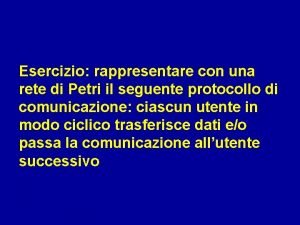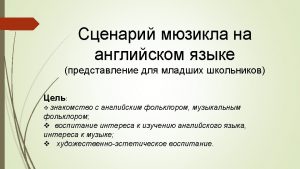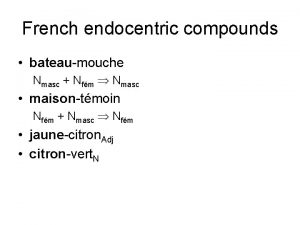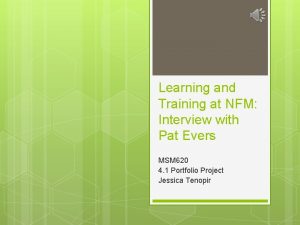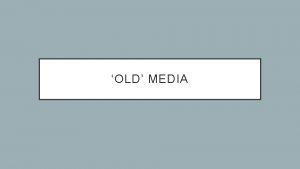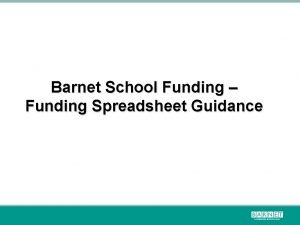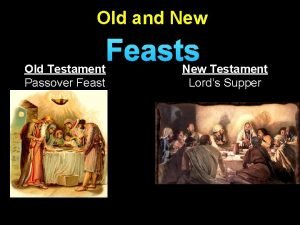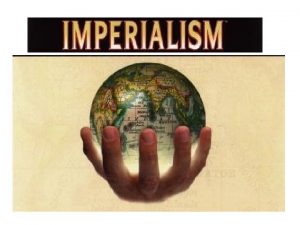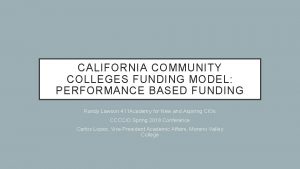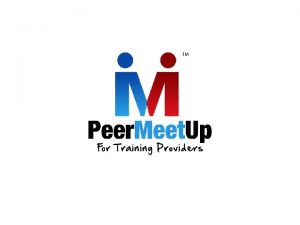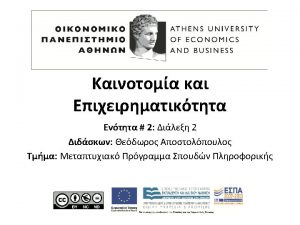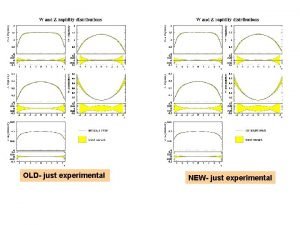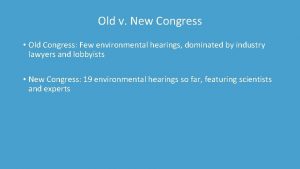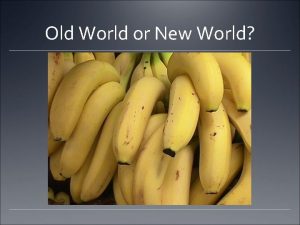New Funding Model NFM Old vs the New
























- Slides: 24

New Funding Model (NFM)

Old vs. the New Previous Model u u u Passive role by the Secretariat in influencing investments Timelines largely defined by the Global Fund Hands-off Secretariat role prior to Board approval Low predictability: timing of Rounds, success rates and available funds Cumbersome undifferentiated process to grant signing with different delays New Model u u u More active portfolio management to optimize impact Timelines largely defined by each country Engagement by Global Fund Country Teams in country dialogue and concept note development High predictability: timing, success rates, indicative funding range Disbursement-ready grants

Key Features Eligible countries can apply at any point during the three Flexible Time. Line year allocation period so that funding aligns with national budgeting cycles Predictability Simplicity Enhanced Engagement All eligible countries receive an indicative funding amount. The Global Fund Secretariat adjusts these amounts to account for implementers’ circumstances. A more streamlined concept note begins the process of applying for a grant. The Global Fund engages in ongoing country dialogue with a focus on multi-stakeholder participation, prior to Board approval of grants

Key Features Band 1: Lower income, higher burden u Band 2 : Lower income, lower burden u Band 3 : Higher income, higher burden u

Allocation Formula Prior to aggregation to bands Qualitative factors Performance Disease burden Impact Income level Rate of infection External financing Minimum required Country indicative allocation Absorptive capacity Risk 2014 -2016: 50% for HIV/AIDS, 32% for malaria, and 18% for tuberculosis. Willingness to Pay (determined during country dialogue to access last 15% of indicative funding)

NFM Process TRP reviews new funding requests in an independent and transparent way. u The TRP makes its funding recommendation on the indicative and above indicative amounts, prioritizing interventions u The Global Fund Grant Approvals Committee (GAC) to determine the upper-ceiling for the budget. *TRP: Technical Review Panel GAC: Grant Approvals Committee u

Goals Impact indicator s Objectives Outcome indicators Coverage / output indicators Modular approach Module 1 Module 2 Module 3 Intervention 1 A Intervention 1 B Intervention 1 C Intervention 2 A Intervention 2 B Intervention 2 C Intervention 2 D • Description of activities • Responsible PR • Budget

Preparation for NFM 1. 2. 3. 4. 5. Plan ahead Strengthen National Strategies Involve key groups Consolidate information and update data Ensure CCM and PR will be able to do the work

Questions and Comments

Performance-Based Disbursements DISBURSEMENT PROCESS PR LFA FPM Progress Update & Disbursement Request Progress Review & Disbursement Recommendation Performance Evaluation & Disbursement Decision § Contextual Information § Verification of: - Reported Results - Reported Expenditures - Fulfillment of CPs § Advancement on Conditions Precedent (CPs) § Review of Contextual Information § Disbursement Request Amount § Performance Evaluation and Rating § Results vs. Targets § Expenditures vs. Budget § Review of: - Programmatic Results - Financial Performance - Contextual Information - Fulfillment of CPs § Performance Evaluation and Rating § Disbursement Decision § LFA Recommendations § Recommended Disbursement Amount GF DISBURSEMENT & MANAGEMENT LETTER

CCM Oversight Cycle 3. CCM Oversight Committee Review of DB & selection of possible actions 1. PR Submits Data (Entry Page) & PU/DR CC M S an ecr d P eta R ri at 2. CCM Secretariat Prepares Consolidated DB & Observations. CCM Over sight 4. Submits Summary DB & Recommendation Comm ittee CCM 7. CCM Secretariat Coordinates Response and Solution Providers 6. Discuss issues & approve actions. 5. CCM Meeting

Purpose of Site Visit Identify problems and bottlenecks hindering implementation. u Strategic information gathering (Money/Drug/Implementation/performance). u Representation (CCM members involvement). u Building relationship with PR. u Engage development partners to help with the GF grant oversight, u

Challenges to grant oversight Increasing number of grants and PRs – volume of information. u No time for oversight – busy schedule u Too many details in the PU/DR reports, not enough details in verbal or narrative reports u Capacity of the CCM u Getting information too late to provide real oversight. u

Keys to Successful CCM Oversight u CCM takes the time to understand the grants u CCM develops a close relationship with PRs u u u CCM mobilizes sufficient technical expertise to enrich the oversight committee or technical working groups CCM acts quickly once a sign of flagging performance or weak management is identified – does not wait for the Global Fund visit / Management letters! CCM contributes to grant performance!

Dashboards for CCMs and PRs PR EARLY PR DASHBOAR DS 2006 -2007 pre-GMS CCM GRANT OVERSIGHT DASHBOARDS 2007 -2012 GMS 1 MANAGEMENT DASHBOARD & CCM SUMMARY 2012 -2017 GMS 2


How it works Dashboard shared with SRs & other stakeholders as Powerpoint or Pdf SRs send data to PR as Excel file PR-licensed SAP software creates master file, generates Dashboard PR reviews SR data, inputs own data

Support COLLECTIVE or INDIVIDUAL REQUESTS CCM & PRs Multiple TA Channel

Performance Framework

Performance Framework: What is it? The Performance Framework (PF) is the legal statement of the expected performance and impact over proposal term Includes an agreed set of indicators and targets consistent with the proposal to be reported on a regular basis (depending on measurement methods)

Key terms in PF u u u Modules: key services to be delivered are grouped under standard service delivery areas as defined in M&E Plan Directly tied / Untied: Indicators are “tied” if related activities are primarily funded by specific grant. Indicators are “untied” if they reflect a broader national program. Cumulative vs. Non-Cumulative Targets: Targets can be cumulative over program term, cumulative annually, or not cumulative.

Let’s walk through a Performance Framework!

PU/DR u PU/DR contains: u Programmatic progress against targets u Financial accounting u Request for ongoing funding u Update on CPs, any other requirements (related to the Grant Agreement) u Response to any GF queries

Questions and Comments
 Nfm token
Nfm token Product funding model
Product funding model New-old approach to creating new ventures
New-old approach to creating new ventures Njbta
Njbta What's your name? how old are you?
What's your name? how old are you? Once upon a time there lived a little girl
Once upon a time there lived a little girl Once upon a time there lived an old man and an old woman
Once upon a time there lived an old man and an old woman Once upon a time there lived a father
Once upon a time there lived a father Hát kết hợp bộ gõ cơ thể
Hát kết hợp bộ gõ cơ thể Bổ thể
Bổ thể Tỉ lệ cơ thể trẻ em
Tỉ lệ cơ thể trẻ em Voi kéo gỗ như thế nào
Voi kéo gỗ như thế nào Tư thế worm breton
Tư thế worm breton Chúa yêu trần thế
Chúa yêu trần thế Các môn thể thao bắt đầu bằng tiếng chạy
Các môn thể thao bắt đầu bằng tiếng chạy Thế nào là hệ số cao nhất
Thế nào là hệ số cao nhất Các châu lục và đại dương trên thế giới
Các châu lục và đại dương trên thế giới Công thức tính độ biến thiên đông lượng
Công thức tính độ biến thiên đông lượng Trời xanh đây là của chúng ta thể thơ
Trời xanh đây là của chúng ta thể thơ Mật thư anh em như thể tay chân
Mật thư anh em như thể tay chân 101012 bằng
101012 bằng Phản ứng thế ankan
Phản ứng thế ankan Các châu lục và đại dương trên thế giới
Các châu lục và đại dương trên thế giới Thể thơ truyền thống
Thể thơ truyền thống
